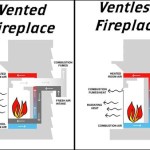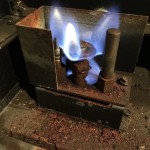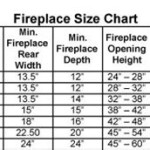How To Install Vented Gas Logs In An Existing Fireplace
Vented gas logs offer an aesthetically pleasing alternative to traditional wood-burning fireplaces while providing the convenience of gas. Installation within an existing fireplace is a manageable project for experienced DIY enthusiasts, though enlisting a qualified professional is always recommended, particularly when gas line connections are involved. This article outlines the steps involved in safely and effectively installing vented gas logs.
Before commencing installation, it is crucial to ensure the existing fireplace and chimney are in good working order. This includes a thorough inspection for any cracks, leaks, or obstructions. The chimney should be professionally cleaned to remove creosote and debris, ensuring proper ventilation and reducing the risk of carbon monoxide poisoning. A damaged or improperly maintained chimney can lead to dangerous conditions, negating the safety advantages of using gas logs over wood.
Furthermore, local building codes and regulations concerning gas appliance installations must be consulted. These codes vary by location and may dictate specific requirements for venting, gas line connections, and safety features. Adhering to these regulations is not only a legal obligation but also essential for the safe operation of the gas logs.
Preparing the Fireplace
The first step in installing vented gas logs is preparing the existing fireplace. This involves removing any remaining ash or debris from previous wood-burning fires. The firebox should be thoroughly cleaned to ensure a level surface for the gas log set. Consider wearing appropriate protective gear, such as gloves and a dust mask, during this process.
Next, the existing gas line should be located and assessed. If a gas line is already present, it must be inspected for leaks and proper shut-off valve functionality. If a gas line needs to be installed, it is highly recommended to hire a qualified gas professional to handle this aspect of the installation. Improper gas line installation can be extremely dangerous and lead to gas leaks or explosions.
The fireplace damper must be permanently fixed in the open position. This is a critical safety measure, as vented gas logs produce carbon monoxide and require unimpeded airflow up the chimney. Damper clamps or other locking mechanisms designed for this purpose should be used to prevent accidental closure. Consult the gas log manufacturer’s instructions for specific recommendations on damper positioning.
Installing the Gas Log Set
Once the fireplace is prepared, the gas log set can be installed. Begin by carefully placing the burner assembly within the firebox, following the manufacturer’s instructions. The burner should be positioned so that the gas flames will evenly distribute across the logs and provide a realistic flame pattern. The burner typically connects to the existing gas line using a flexible gas connector or a rigid pipe connection. Again, it is strongly advised to have a qualified professional make this connection to ensure it is properly sealed and leak-free.
After connecting the gas line, a leak test is essential. Apply a soapy water solution to all gas connections and observe for any bubbles, which indicate a gas leak. If a leak is detected, immediately shut off the gas supply and tighten the connections or replace the fittings as necessary. Repeat the leak test until all connections are leak-free. Never use an open flame to check for gas leaks.
The gas logs themselves should then be carefully arranged on the burner assembly according to the manufacturer's instructions. The logs are typically designed to interlock or fit in a specific configuration to ensure proper flame distribution and prevent the logs from interfering with the burner. Avoid placing the logs too close to the burner ports, as this can create soot and reduce the efficiency of the gas logs.
Testing and Final Adjustments
With the gas logs installed, the system should be thoroughly tested. Turn on the gas supply and ignite the burner according to the manufacturer's instructions. Observe the flame pattern and ensure that the flames are burning cleanly and evenly across the logs. Adjust the gas flow, if necessary, to achieve the desired flame height and appearance.
Inspect the chimney draft to ensure proper ventilation. A strong updraft is essential for carrying away combustion byproducts, such as carbon monoxide. If the draft seems weak or nonexistent, further investigation is warranted to identify potential obstructions or airflow problems. Consider having a professional chimney sweep inspect the chimney to ensure it is functioning correctly.
Finally, once the system is operating correctly, install any remaining accessories, such as decorative embers or lava rocks, according to the manufacturer's instructions. These accessories can enhance the aesthetic appeal of the gas logs and create a more realistic fireplace experience.
Carbon monoxide detectors should be installed within the home, particularly near the fireplace, to provide early warning of any potential carbon monoxide leaks. Regularly test the detectors to ensure they are functioning properly. Familiarize oneself with the symptoms of carbon monoxide poisoning, such as headache, dizziness, and nausea, and seek immediate medical attention if these symptoms occur.
Regular maintenance of the gas log set is essential for ensuring safe and efficient operation. This includes cleaning the burner assembly to remove debris and inspecting the gas lines for leaks. Consult the manufacturer's instructions for specific maintenance recommendations. If any problems are detected, such as gas leaks or unusual flame patterns, immediately shut off the gas supply and contact a qualified gas professional for assistance.

How To Select And Install A Gas Fireplace Log Set Fireplaces Direct Learning Center

How To Select And Install A Gas Fireplace Log Set Fireplaces Direct Learning Center

How To Put In A Gas Log Set For Fireplace

Episode 276 Installing A Gas Log Set In The Family Room Fireplace

How To Install A Gas Log Fireplace Ask This Old House

We Install Gas Logs Amarillo Tx West Chimney

Can I Install Gas Logs In My Existing Fireplace Thomas Bros Propane

Update Your Wood Fireplace To A Gas

Vented Vs B Vent Direct Free Dixie S

If You Have A Gas Fireplace It May Or Not Chimney Flue
Related Posts








